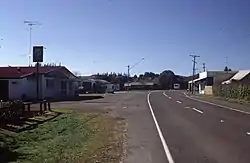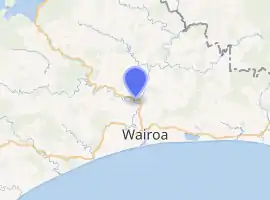Frasertown
Frasertown is a small settlement in the northern Hawke's Bay Region of New Zealand's eastern North Island.
Frasertown | |
|---|---|
 | |

| |
| Coordinates: | |
| Country | |
| Region | Hawke's Bay |
| Territorial authority | Wairoa District |
| Population (2018)[1] | |
| • Total | 255 |
It is located inland from Wairoa at the junction of SH38, and the inland route (the Tiniroto Road; the former SH36) to Gisborne. State Highway 38 leads from Wai-O-Tapu via Murupara, The Ureweras, Lake Waikaremoana and Frasertown to Wairoa. It gives a short, but (partly) unsealed, winding and climbing connection to the Central North Island Rotorua.
Demographics
The population of Frasertown was 255 in the 2018 census, an increase of 42 from 2013. There were 120 males and 135 females. 52.9% of people identified as European/Pākehā, 57.7% as Māori and 2.4% as Pacific peoples. 22.4% were under 15 years old, 16.5% were 15–29, 40.0% were 30–64, and 22.4% were 65 or older.[1]
| Year | Pop. | ±% p.a. |
|---|---|---|
| 2006 | 927 | — |
| 2013 | 861 | −1.05% |
| 2018 | 861 | +0.00% |
| Source: [2] | ||
The statistical area of Frasertown-Ruakituri, which at 1,333 square kilometres is much larger than this town and also covers Ohuka and Ruakituri, had a population of 861 at the 2018 New Zealand census, unchanged since the 2013 census, and a decrease of 66 people (-7.1%) since the 2006 census. There were 324 households. There were 444 males and 420 females, giving a sex ratio of 1.06 males per female. The median age was 39 years (compared with 37.4 years nationally), with 192 people (22.3%) aged under 15 years, 153 (17.8%) aged 15 to 29, 369 (42.9%) aged 30 to 64, and 147 (17.1%) aged 65 or older.
Ethnicities were 69.3% European/Pākehā, 45.6% Māori, 1.0% Pacific peoples, 0.3% Asian, and 1.0% other ethnicities (totals add to more than 100% since people could identify with multiple ethnicities).
The proportion of people born overseas was 4.5%, compared with 27.1% nationally.
Although some people objected to giving their religion, 44.6% had no religion, 38.0% were Christian and 11.1% had other religions.
Of those at least 15 years old, 72 (10.8%) people had a bachelor or higher degree, and 162 (24.2%) people had no formal qualifications. The median income was $28,700, compared with $31,800 nationally. The employment status of those at least 15 was that 342 (51.1%) people were employed full-time, 123 (18.4%) were part-time, and 18 (2.7%) were unemployed.[2]
Marae
The township includes a number of marae (meeting grounds) and wharenui (meeting houses) for the local iwi (tribe) of Ngāti Kahungunu and its hapū (sub-tribes):[3][4]
- Aranui Marae and Arapera or Te Poho o Ngapera wharenui, affiliated with Ngāi Tamaterangi and Ngāti Peehi hapū.
- Arimawha Marae, affiliates with Ngāti Tamaterangi hapū.
- Pākōwhai Marae and Te Huinga o Te Aroha wharenui, affiliated with Ngāti Mihi hapū.
- Pūtahi Marae and Te Poho o Hinepehinga wharenui, affiliated with Ngāti Hinepehinga hapū.
In October 2020, the Government committed $1,949,075 from the Provincial Growth Fund to upgrade all four marae and 20 other Ngāti Kahungunu marae, creating 164 jobs.[5]
Education
Frasertown School is a Year 1–6 co-educational state primary school.[6] It is a decile 4 school with a roll of 125 as of March 2020.[7][8]
References
- "Age and sex by ethnic group (grouped total response), for census usually resident population counts, 2006, 2013, and 2018 Censuses (urban rural areas)". Statistics New Zealand. Retrieved 7 January 2021.
- "Statistical area 1 dataset for 2018 Census". Statistics New Zealand. March 2020. Frasertown-Ruakituri (207600). 2018 Census place summary: Frasertown-Ruakituri
- "Te Kāhui Māngai directory". tkm.govt.nz. Te Puni Kōkiri.
- "Māori Maps". maorimaps.com. Te Potiki National Trust.
- "Marae Announcements" (Excel). growregions.govt.nz. Provincial Growth Fund. 9 October 2020.
- "Ministry of Education School Profile". educationcounts.govt.nz. Ministry of Education.
- "New Zealand Schools Directory". New Zealand Ministry of Education. Retrieved 26 April 2020.
- "Education Review Office Report". ero.govt.nz. Education Review Office.
